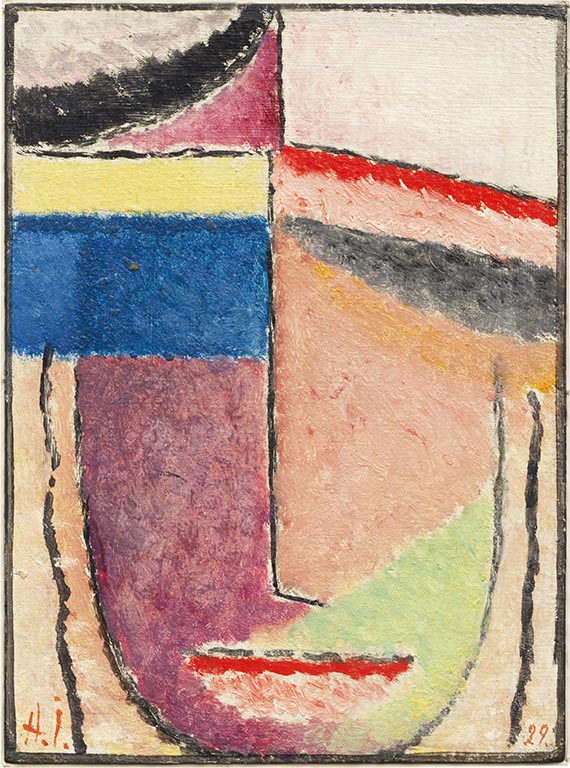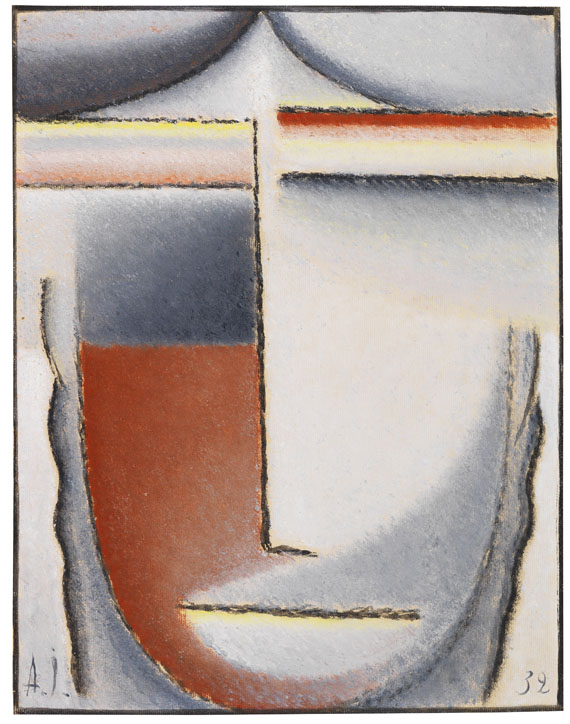154
Alexej von Jawlensky
Abstrakter Kopf, 1929.
Oil on cardboard, laminated on panel
Estimation: € 100,000 / $ 116,000
Alexej von Jawlensky
1864 - 1941
Abstrakter Kopf. 1929.
Oil on cardboard, laminated on panel.
Monogrammed in the lower left and dated in the lower right. 21.7 x 16 cm (8.5 x 6.2 in).
• “Abstract Head” - a symbol of the transition from Expressionism to heightened abstraction.
• Harmonious colors in the artist’s unmistakable style from the important series of the “Abstract Heads.”
- The painting is exemplary of Jawlensky's meditative, spiritually infused portraits.
• The clear formal language combined with the radiant colors lend the portrait a timeless modernity.
• Significant provenance: From the Max Niedermayer Collection, Wiesbaden.
A certificate of authenticity has been requested from the Alexej von Jawlensky Archive, Wiesbaden/Muralto.
PROVENANCE: Max Niedermayer Collection, Wiesbaden (probably directly from the artist).
Private collection, Wiesbaden (since 1968, inherited from the above).
Private collection, Rhineland-Palatinate (since 1979, acquired from the above, collection stamp on the reverse).
Private collection, Rhineland-Palatinate (inherited from the above).
Called up: December 6, 2025 - ca. 14.12 h +/- 20 min.
1864 - 1941
Abstrakter Kopf. 1929.
Oil on cardboard, laminated on panel.
Monogrammed in the lower left and dated in the lower right. 21.7 x 16 cm (8.5 x 6.2 in).
• “Abstract Head” - a symbol of the transition from Expressionism to heightened abstraction.
• Harmonious colors in the artist’s unmistakable style from the important series of the “Abstract Heads.”
- The painting is exemplary of Jawlensky's meditative, spiritually infused portraits.
• The clear formal language combined with the radiant colors lend the portrait a timeless modernity.
• Significant provenance: From the Max Niedermayer Collection, Wiesbaden.
A certificate of authenticity has been requested from the Alexej von Jawlensky Archive, Wiesbaden/Muralto.
PROVENANCE: Max Niedermayer Collection, Wiesbaden (probably directly from the artist).
Private collection, Wiesbaden (since 1968, inherited from the above).
Private collection, Rhineland-Palatinate (since 1979, acquired from the above, collection stamp on the reverse).
Private collection, Rhineland-Palatinate (inherited from the above).
Called up: December 6, 2025 - ca. 14.12 h +/- 20 min.
The painting “Abstract Head” from 1929 is emblematic of a central phase in the late work of the Russian-German artist Alexej von Jawlensky, in which his artistic development from expressive figuration to spiritual abstraction becomes more concentrated. The depiction of a stylized face, reduced to a few geometric shapes and clearly structured colors, is typical of the so-called “Heads” series, which Jawlensky pursued from the 1910s until the end of his life. The works of the late 1920s, including ours, are characterized by an intense and bold formal simplification.
The head is composed in a strict formal language: the mouth and forehead are arranged on a horizontal axis—next to it, the vertical axis of the nose creates a strong contrast in the frontal heraldic U-shape that is characteristic of all “Abstract Heads”. The facial features are de-individualized, giving the portrait an almost iconic effect. The harmonious color scheme does not follow any naturalistic logic; instead, Jawlensky's expressionist background remains evident. Consequently, the colors can be interpreted primarily as an expression of inner states of mind.
Formally, the work stands between Expressionism and spiritually inspired abstraction. Alexej von Jawlensky himself, influenced by Russian Orthodox icon painting and theosophy, ultimately understood his heads in his last phase of work as ”Meditations” – as visual forms of contemplation and spiritual concentration. Thus, “Abstract Head” becomes a medium for a universal spiritual experience, beyond individual physiognomy and purely aesthetic representation. It is an image of the inner self—calm, concentrated, and timeless. [MH]
The head is composed in a strict formal language: the mouth and forehead are arranged on a horizontal axis—next to it, the vertical axis of the nose creates a strong contrast in the frontal heraldic U-shape that is characteristic of all “Abstract Heads”. The facial features are de-individualized, giving the portrait an almost iconic effect. The harmonious color scheme does not follow any naturalistic logic; instead, Jawlensky's expressionist background remains evident. Consequently, the colors can be interpreted primarily as an expression of inner states of mind.
Formally, the work stands between Expressionism and spiritually inspired abstraction. Alexej von Jawlensky himself, influenced by Russian Orthodox icon painting and theosophy, ultimately understood his heads in his last phase of work as ”Meditations” – as visual forms of contemplation and spiritual concentration. Thus, “Abstract Head” becomes a medium for a universal spiritual experience, beyond individual physiognomy and purely aesthetic representation. It is an image of the inner self—calm, concentrated, and timeless. [MH]
154
Alexej von Jawlensky
Abstrakter Kopf, 1929.
Oil on cardboard, laminated on panel
Estimation: € 100,000 / $ 116,000
Commission, taxes et droit de suite
Cet objet est offert avec imposition régulière ou avec imposition différentielle.
Calcul en cas d'imposition différentielle:
Prix d’adjudication jusqu’à 1 000 000 euros : frais de vente 34 %.
Des frais de vente de 29% sont facturés sur la partie du prix d’adjudication dépassant 1 000 000 euros. Ils sont additionnés aux frais de vente dus pour la partie du prix d’adjudication allant jusqu’à 1 000 000 euros.
Des frais de vente de 22% sont facturés sur la partie du prix d’adjudication dépassant 4 000 000 euros. Ils sont additionnés aux frais de vente dus pour la partie du prix d’adjudication allant jusqu’à 4 000 000 euros.
La commission comprend la TVA, mais celle-ci n'est pas indiquée.
Calcul en cas d'imposition régulière:
Prix d'adjudication jusqu'à 1 000 000 € : 29 % de commission.
Prix d'adjudication supérieur à 1 000 000 € : montants partiels jusqu'à 1 000 000 € 29 % de commission, montants partiels supérieurs à 1 000 000 € : 23 % de commission.
Prix d'adjudication supérieur à 4.000 000 € : montants partiels supérieurs à 4.000 000 € : 15 % de commission.
La TVA légale de 7 % est prélevée sur la somme du prix d'adjudication et de la commission.
Si vous souhaitez appliquer l'imposition régulière, merci de bien vouloir le communiquer par écrit avant la facturation.
Calcul en cas de droit de suite:
Pour les œuvres originales d’arts plastiques et de photographie d’artistes vivants ou d’artistes décédés il y a moins de 70 ans, soumises au droit de suite, une rémunération au titre du droit de suite à hauteur des pourcentages indiqués au § 26, al. 2 de la loi allemande sur les droits d’auteur (UrhG) est facturée en sus pour compenser la rémunération liée au droit de suite due par le commissaire-priseur conformément au § 26 UrhG. À ce jour, elle est calculée comme suit :
4 pour cent pour la part du produit de la vente à partir de 400,00 euros et jusqu’à 50 000 euros,
3 pour cent supplémentaires pour la part du produit de la vente entre 50 000,01 et 200 000 euros,
1 pour cent supplémentaire pour la part entre 200 000,01 et 350 000 euros,
0,5 pour cent supplémentaire pour la part entre 350 000,01 et 500 000 euros et
0,25 pour cent supplémentaire pour la part au-delà de 500 000 euros.
Le total de la rémunération au titre du droit de suite pour une revente s’élève au maximum à 12 500 euros.
Calcul en cas d'imposition différentielle:
Prix d’adjudication jusqu’à 1 000 000 euros : frais de vente 34 %.
Des frais de vente de 29% sont facturés sur la partie du prix d’adjudication dépassant 1 000 000 euros. Ils sont additionnés aux frais de vente dus pour la partie du prix d’adjudication allant jusqu’à 1 000 000 euros.
Des frais de vente de 22% sont facturés sur la partie du prix d’adjudication dépassant 4 000 000 euros. Ils sont additionnés aux frais de vente dus pour la partie du prix d’adjudication allant jusqu’à 4 000 000 euros.
La commission comprend la TVA, mais celle-ci n'est pas indiquée.
Calcul en cas d'imposition régulière:
Prix d'adjudication jusqu'à 1 000 000 € : 29 % de commission.
Prix d'adjudication supérieur à 1 000 000 € : montants partiels jusqu'à 1 000 000 € 29 % de commission, montants partiels supérieurs à 1 000 000 € : 23 % de commission.
Prix d'adjudication supérieur à 4.000 000 € : montants partiels supérieurs à 4.000 000 € : 15 % de commission.
La TVA légale de 7 % est prélevée sur la somme du prix d'adjudication et de la commission.
Si vous souhaitez appliquer l'imposition régulière, merci de bien vouloir le communiquer par écrit avant la facturation.
Calcul en cas de droit de suite:
Pour les œuvres originales d’arts plastiques et de photographie d’artistes vivants ou d’artistes décédés il y a moins de 70 ans, soumises au droit de suite, une rémunération au titre du droit de suite à hauteur des pourcentages indiqués au § 26, al. 2 de la loi allemande sur les droits d’auteur (UrhG) est facturée en sus pour compenser la rémunération liée au droit de suite due par le commissaire-priseur conformément au § 26 UrhG. À ce jour, elle est calculée comme suit :
4 pour cent pour la part du produit de la vente à partir de 400,00 euros et jusqu’à 50 000 euros,
3 pour cent supplémentaires pour la part du produit de la vente entre 50 000,01 et 200 000 euros,
1 pour cent supplémentaire pour la part entre 200 000,01 et 350 000 euros,
0,5 pour cent supplémentaire pour la part entre 350 000,01 et 500 000 euros et
0,25 pour cent supplémentaire pour la part au-delà de 500 000 euros.
Le total de la rémunération au titre du droit de suite pour une revente s’élève au maximum à 12 500 euros.




 Lot 154
Lot 154 






